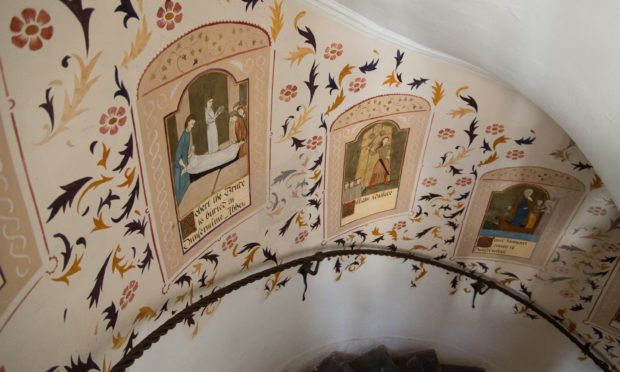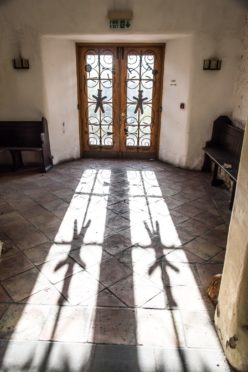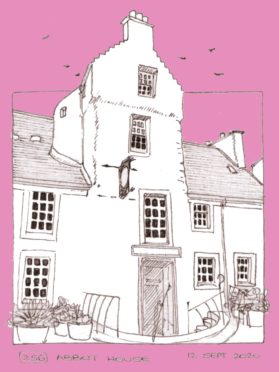If the walls of Abbot House in Dunfermline could talk, they would be saying how much they’re looking forward to being rid of their scaffolding.
The old lady is still in the pink, but at the landmark building in Maygate, the finishing touches are being made to a restoration that should take the 500-year-old, A-listed structure well into this century and pin it to the Fife tourism map.
The overall repair programme has cost around £600k, gathered from Carnegie Dunfermline Trust who own the building, Fife Council, Dunfermline Area Committee, the Common Good Fund and last week Historic Environment Scotland awarding Abbot House £110, 349 to help the building in its ambitions to be a community cultural hub with a café, shop and rentable workshop space.
#ICYMI, we've awarded two more projects funding for repairs through our Historic Environment Repair Grant programme.
Find out how we'll be helping Abbot House in Dunfermline & the Balloch Steam slipway on the banks of Loch Lomond ➡ https://t.co/cLwNQhYoMV #HESsupported
— Historic Environment Scotland (@HistEnvScot) March 28, 2021
The HES-funded repairs are being carried out both internally and externally, including work to the lime plaster, windows, and roofing and being carried out heritage specialist stonemasons G. Brown Stonemason Ltd, who also worked on St Margaret’s RC Memorial Church in the town. The work is expected to late summer this year and will include an opportunity for the community to attend heritage skills workshops.
There will be a phased opening, with classes in the outside workshop, creative rental space and the opening of an education centre on the first floor, including a digital archive of Abbot House. A digital archive featuring photographs, drawings, architectural plans, documents, and local records relating to the house will also be accessible to the public.
The renovation of the coffee shop will follow on from current works and is now planned for early 2022 reopening, due to the knock-on effect of the pandemic.
“Obviously it’s a much-loved building, but given its age and the complexities of its upkeep it’s also a very expensive building to keep running,” says operations manager Louise Hutchison.
“In living memory, it’s actually been quite a practical building and was used as flats until the 1960s but in recent years it’s been better known as a heritage centre, which was popular enough, but there was always potential for a broader audience.”
Following the closure of the building in 2015, Carnegie Dunfermline trust started to explore ways in which it could be reopened. The important aspect was making sure that the building was sustainable, while making sure the wider community could enjoy it.
“From our point of view it has to have that business focus as well,” adds Louise Hutchison. “It would be lovely to be able to simply open the doors and offer a free facility, but we have to maintain that balance between what we can offer to our community and visitors and what we need to do on the business side to keep it going..”
Louise adds that in the community focus they have been inspired by the work of Patrick Geddess, the town planner who was responsible for Edinburgh’s New Town.
“He’s also credited with making sure that the Old Town didn’t go too ruin, by involving the community and looking at how the environment that people live in can have a marked effect on their well being.
“Patrick Geddes was also asked by the Carnegie Dunfermline trust to do a town plan for Dunfermline in 1904, and he was based in Abbot House while he did that. Unfortunately the plan wasn’t implemented, I think it might have been a little too forward thinking at the time, but what we want to do is embrace spirit of his desire to have an environment that will bring people together.”
Once the buildings opens fully, the first floor of the house will be the gift shop and coffee shop. The education centre with the digital archive will be on the second and the third will house the artist rental space.
“It was important to get the shop open first. Even though the whole building isn’t open at the moment we still have costs to cover such as insurance and heating and lighting.
“There’s a big focus on supporting local business and in our gift shop already 50% of our shop works on a sale or return basis with local artisans. This isn’t people with hobbies this is real strong local businesses, but once they really wouldn’t get an opportunity to have a High Street presence. We’ve only been opened for four months but the shop is already in profit.”
The shop works closely with local artists and makers, giving them a profile that they might not otherwise get but she is keen to stress that the artisan tag isn’t an exclusive one.
“I think the shop gives some idea of what the café will be. We will use as many local suppliers as possible, and there will be an element of the artisan but only to offer quality not exclusivity.”
As part of the Dunfermline Heritage Partnership, there is more collaborative working to make sure that when visitors come to the town they don’t leave a coach, visit the Abbey and then leave for St Andrews.
“What we’re trying to do here is respect the old, but embrace the new. We have to make Abbot House fit for the modern audience, but always have to acknowledge why we’re here and where we’ve come from.”


